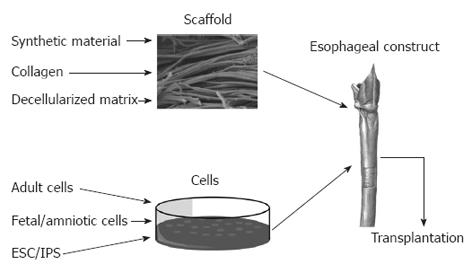Copyright
©2012 Baishideng Publishing Group Co.
World J Gastroenterol. Dec 21, 2012; 18(47): 6900-6907
Published online Dec 21, 2012. doi: 10.3748/wjg.v18.i47.6900
Published online Dec 21, 2012. doi: 10.3748/wjg.v18.i47.6900
Figure 1 Esophageal tissue engineering.
A tissue-engineered esophageal construct may be created by the combination of a scaffold and cells, grown in a bioreactor and transplanted in patients. A three-dimensional scaffold may be created from synthetic material, collagen or a decellularized matrix. Cells for the use of tissue engineering are derived from a number of sources such as the adult, fetus and the embryo. Additionally, non-seeded scaffolds may be transplanted with the aim of being repopulated by host cells. ESC: Embryonic stem cells; IPS: Induced pluripotent stem cells.
- Citation: Totonelli G, Maghsoudlou P, Fishman JM, Orlando G, Ansari T, Sibbons P, Birchall MA, Pierro A, Eaton S, De Coppi P. Esophageal tissue engineering: A new approach for esophageal replacement. World J Gastroenterol 2012; 18(47): 6900-6907
- URL: https://www.wjgnet.com/1007-9327/full/v18/i47/6900.htm
- DOI: https://dx.doi.org/10.3748/wjg.v18.i47.6900









